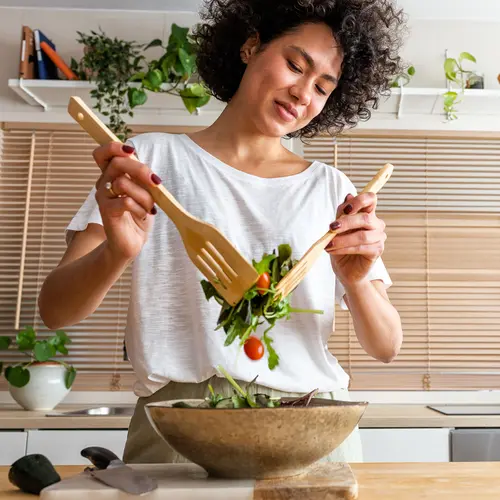Rhubarb (scientific name Rheum rhabarbarum) is a vegetable that many people use like a fruit in cooking and recipes. Though native to Asia, it grows in other parts of the world, including the United States. The plant prefers cooler environments as it doesn’t fare well in the heat.
The long red leafstalks grow in the spring, peaking in mid-April. Only the stalks of the plant are edible. The leaves contain toxins and high concentrations of oxalic acid. The stalks themselves are fleshy, sour, and acidic. While you can eat them raw, many people prefer them cooked.
Rhubarb has a long history, with roots in ancient Chinese medicine. It was also used in ancient Arab, Greek, and Roman civilizations. Today, it is popular in jams, pies, compotes, and even drinks.
Health Benefits
Rhubarb is an excellent source of vitamin K, which is an essential vitamin for bone health and blood clotting. The vitamin A in rhubarb may also help to fight free radicals that cause skin damage and premature aging, keeping your skin looking healthy and youthful. It’s also high in antioxidants, and many other important vitamins and minerals that provide a variety of health benefits.
The vitamin K content of rhubarb helps you maintain strong, healthy bones. Vitamin K is important for bone formation and it can help prevent osteoporosis.
Rhubarb is an excellent source of fiber, which helps to lower cholesterol. Studies show that rhubarb helps lower your bad cholesterol levels as well as your total cholesterol. Lower cholesterol levels reduce your risk for heart disease and heart attack. The vitamin K in rhubarb may also aid in preventing the calcification of blood vessels. The antioxidants in the vegetable also provide anti-inflammatory effects, which can further help to protect your heart health.
The fiber in rhubarb helps keep things moving through your digestive tract, preventing problems such as constipation. It also contains compounds called sennosides, which act as natural laxatives. The tannins in rhubarb also provide anti-diarrheal effects.
The antioxidants in rhubarb help fight free radicals in the body, which may help to protect against oxidative stress and cell damage. The free radical-fighting properties of antioxidants may reduce your risk of developing certain types of cancer.
The antioxidant compounds in rhubarb help to fight inflammation. These properties may be helpful to people with systemic inflammatory reaction syndrome. Another study found that the anti-inflammatory properties of rhubarb extract can help improve wound healing.
Nutrition
Rhubarb is rich in antioxidants, particularly anthocyanins (which give it its red color) and proanthocyanidins. These antioxidants have anti-bacterial, anti-inflammatory, and anti-cancer properties, which help protect you from many health-related issues such as heart disease, cancer, and diabetes.
Other nutrients in rhubarb include:
Nutrients Per Serving
A half-cup serving of rhubarb contains:
- Calories: 13
- Protein: 1 gram
- Fat: 0 grams
- Carbohydrates: 3 grams
- Fiber: 1 gram
- Sugar: 1 gram
Things to Watch Out For
Rhubarb is high in calcium oxalate. While the substance is mainly in the leaves, it’s also found in the stalks. Too much calcium oxalate in your diet may lead to hyperoxaluria, which is the buildup of oxalate crystals in different organs. These crystals may also promote the formation of kidney stones and increase your risk of kidney failure.
Rhubarb’s vitamin K content may also interfere with the blood-thinning medication warfarin. It can reduce the effectiveness of the medication, so be sure to talk with your doctor if you want to incorporate rhubarb into your diet.
How to Eat Rhubarb
You may find fresh rhubarb in your grocery store’s produce section when the vegetable is in season, which is typically from April to June.
When choosing rhubarb, look for stalks that are firm and crisp. Avoid ones that are limp or have blemishes. Look for ones with small leaves, which indicate a younger plant, but be sure to remove the leaves before cooking or eating.
Don’t cut the stalks until you’re ready to use the rhubarb, or else the vegetable may dry out. To store them, place whole stalks into a sealed plastic bag in the refrigerator. Use them within one week. If you want to preserve your rhubarb for later use, cut it and store the pieces in the freezer until you’re ready to use them.
You can eat rhubarb in a number of different ways, including raw, blended into a smoothie, or cooked into a rhubarb jam. Other ways to enjoy the vegetable include:
- Baking it into a pie or crumble
- Making rhubarb ice cream
- Adding rhubarb to fresh juices or homemade kombucha
- Blending it into a sauce for meat or poultry
- Pureeing and dehydrating it to make rhubarb leather
- Roasting rhubarb with a drizzle of honey and tossing it in a salad

